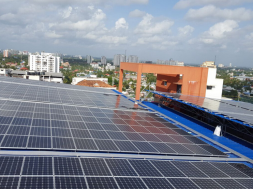
An IIT Delhi alumnus and a world leading scientist, Sasikanth Manipatruni, working at Intel Corp. came up with a new computing switch design that could one day change every computer on the planet. The device is called a magneto-electric spin-orbit logic which aims to be revolutionize computing from handheld and drones to automated driving.
On Dec 3rd, “Nature” published a research paper on the next generation of logic devices authored by researchers from Intel, the University of California, Berkeley, and the Lawrence Berkeley National Laboratory. The paper describes a magneto-electric spin-orbit (MESO) logic device, invented by Intel.
MESO devices have the potential to lower voltage by 5 times and energy by 10-30 times when combined with ultralow sleep state power, as compared to today’s complementary metal-oxide-semiconductors (CMOS). While Intel is pursuing CMOS scaling, the company has been working on computing logic options that will emerge in the next decade for the beyond-CMOS era, driving computing energy-efficiency and allowing performance to grow across diverse computing architectures
Sasikanth Manipatruni (IIT Delhi, EE 2005) has been hard at work looking for a completely new way to do computation that is 100X more efficient and uses quantum materials. Working at Intel’s manufacturing research division, leading the hardware for beyond CMOS devices, he proposed and designed the first MESO switch. Sasikanth is also a KVPY scholar of the Indian Institute of Sciences and did his PhD in quantum and nanophotonics at Cornell.
Recognized last year as an under 40 innovator by IEEE/ACM, Sasikanth’s work at Intel lays out a bold and contrarian vision for computing, one in which Moore’s law continues but with new set of quantum materials.“We are looking for revolutionary, not evolutionary, approaches for computing in the beyond-CMOS era. MESO is built around low-voltage interconnects and low-voltage magneto-electrics. It brings together quantum materials innovation with computing. We are excited about the progress we have made and are looking forward to future demonstrations of reducing the switching voltage even further toward its potential.”
–Ian Young, Intel Senior Fellow and director of the Exploratory Integrated Circuits group in the Technology and Manufacturing Group
“MESO is a device built with room temperature quantum materials,” said Sasikanth Manipatruni, senior staff scientist and director of Intel Science and Technology Center on Functional Electronics Integration and Manufacturing. “It is an example of what is possible, and hopefully triggers innovation across industry, academia and the national labs. A number of critical materials and techniques are yet to be developed to allow the new type of computing devices and architectures.”
Why it Matters: Intel researchers invented the MESO device, with the memory, interconnect and logic requirements of future computing needs in mind. The MESO device was prototyped at Intel using quantum materials with emergent quantum behaviors at room temperature, with magneto-electric materials developed by Ramamoorthy Ramesh at UC Berkeley and the Lawrence Berkeley National Laboratory. MESO also utilizes spin-orbit transduction effects described by Albert Fert at Unité Mixte de Physique CNRS/Thales.
Dr. Sasikanth Manipatruni graduated from IIT Delhi in 2005 as an electrical power engineer with a minor in Physics. He got his PhD working with Michal Lipson at Cornell in Quantum Optics and silicon nanophotonics showing the world’s first 18 Gbit/s electro-optic modulator. He held leadership research positions at GE Global Research and at Intel Corporation. At Intel, Dr. Manipatruni directs the Intel Science and Technology Center on Functional Electronics Integration and Manufacturing (FEINMAN). He holds more than 190 patents (and applications) and >50 research articles published in Nature, Science Advances, Nature Physics, Nature Communications and Physical Review Letters. He was also named an under 40 innovator by IEEE/ACM at the 2017 Design and Automation conference (DAC). (Source: Linked IN)














